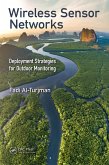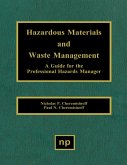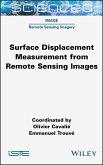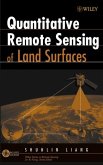Remote Sensing of Land Use and Land Cover (eBook, PDF)
Principles and Applications
Redaktion: Giri, Chandra P.
64,95 €
64,95 €
inkl. MwSt.
Sofort per Download lieferbar

32 °P sammeln
64,95 €
Als Download kaufen

64,95 €
inkl. MwSt.
Sofort per Download lieferbar

32 °P sammeln
Jetzt verschenken
Alle Infos zum eBook verschenken
64,95 €
inkl. MwSt.
Sofort per Download lieferbar
Alle Infos zum eBook verschenken

32 °P sammeln
Remote Sensing of Land Use and Land Cover (eBook, PDF)
Principles and Applications
Redaktion: Giri, Chandra P.
- Format: PDF
- Merkliste
- Auf die Merkliste
- Bewerten Bewerten
- Teilen
- Produkt teilen
- Produkterinnerung
- Produkterinnerung

Bitte loggen Sie sich zunächst in Ihr Kundenkonto ein oder registrieren Sie sich bei
bücher.de, um das eBook-Abo tolino select nutzen zu können.
Hier können Sie sich einloggen
Hier können Sie sich einloggen
Sie sind bereits eingeloggt. Klicken Sie auf 2. tolino select Abo, um fortzufahren.

Bitte loggen Sie sich zunächst in Ihr Kundenkonto ein oder registrieren Sie sich bei bücher.de, um das eBook-Abo tolino select nutzen zu können.
Filling the need for a comprehensive book that covers both theory and application, Remote Sensing of Land Use and Land Cover: Principles and Applications provides a synopsis of how remote sensing can be used for land-cover characterization, mapping, and monitoring from the local to the global scale. With contributions by leading scientists from aro
- Geräte: PC
- mit Kopierschutz
- eBook Hilfe
- Größe: 91.96MB
Andere Kunden interessierten sich auch für
![Remote Sensing of Land Use and Land Cover (eBook, ePUB) Remote Sensing of Land Use and Land Cover (eBook, ePUB)]() Remote Sensing of Land Use and Land Cover (eBook, ePUB)64,95 €
Remote Sensing of Land Use and Land Cover (eBook, ePUB)64,95 €![Land Cover Changes and Their Relationship with Land Surface Temperature Using Remote Sensing Technique (eBook, PDF) Land Cover Changes and Their Relationship with Land Surface Temperature Using Remote Sensing Technique (eBook, PDF)]() Tan Kok ChooiLand Cover Changes and Their Relationship with Land Surface Temperature Using Remote Sensing Technique (eBook, PDF)8,95 €
Tan Kok ChooiLand Cover Changes and Their Relationship with Land Surface Temperature Using Remote Sensing Technique (eBook, PDF)8,95 €![Wireless Sensor Networks (eBook, PDF) Wireless Sensor Networks (eBook, PDF)]() Fadi Al-TurjmanWireless Sensor Networks (eBook, PDF)46,95 €
Fadi Al-TurjmanWireless Sensor Networks (eBook, PDF)46,95 €![Hazardous Gas Monitoring, Fifth Edition (eBook, PDF) Hazardous Gas Monitoring, Fifth Edition (eBook, PDF)]() Logan T. WhiteHazardous Gas Monitoring, Fifth Edition (eBook, PDF)74,95 €
Logan T. WhiteHazardous Gas Monitoring, Fifth Edition (eBook, PDF)74,95 €![Surface Displacement Measurement from Remote Sensing Images (eBook, PDF) Surface Displacement Measurement from Remote Sensing Images (eBook, PDF)]() Olivier CavalieSurface Displacement Measurement from Remote Sensing Images (eBook, PDF)126,99 €
Olivier CavalieSurface Displacement Measurement from Remote Sensing Images (eBook, PDF)126,99 €![Quantitative Remote Sensing of Land Surfaces (eBook, PDF) Quantitative Remote Sensing of Land Surfaces (eBook, PDF)]() Shunlin S. LiangQuantitative Remote Sensing of Land Surfaces (eBook, PDF)211,99 €
Shunlin S. LiangQuantitative Remote Sensing of Land Surfaces (eBook, PDF)211,99 €![Kernel Methods for Remote Sensing Data Analysis (eBook, PDF) Kernel Methods for Remote Sensing Data Analysis (eBook, PDF)]() Kernel Methods for Remote Sensing Data Analysis (eBook, PDF)112,99 €
Kernel Methods for Remote Sensing Data Analysis (eBook, PDF)112,99 €-
-
-
Filling the need for a comprehensive book that covers both theory and application, Remote Sensing of Land Use and Land Cover: Principles and Applications provides a synopsis of how remote sensing can be used for land-cover characterization, mapping, and monitoring from the local to the global scale. With contributions by leading scientists from aro
Dieser Download kann aus rechtlichen Gründen nur mit Rechnungsadresse in A, B, BG, CY, CZ, D, DK, EW, E, FIN, F, GR, HR, H, IRL, I, LT, L, LR, M, NL, PL, P, R, S, SLO, SK ausgeliefert werden.
Produktdetails
- Produktdetails
- Verlag: Taylor & Francis eBooks
- Seitenzahl: 477
- Erscheinungstermin: 19. April 2016
- Englisch
- ISBN-13: 9781420070750
- Artikelnr.: 38295303
- Verlag: Taylor & Francis eBooks
- Seitenzahl: 477
- Erscheinungstermin: 19. April 2016
- Englisch
- ISBN-13: 9781420070750
- Artikelnr.: 38295303
- Herstellerkennzeichnung Die Herstellerinformationen sind derzeit nicht verfügbar.
Chandra P. Giri, PhD, is a research physical scientist at the U.S. Geological Survey (USGS)/Earth Resources Observation and Science (EROS) Center, where he leads the International Land Cover and Biodiversity program. He is also a guest/adjunct faculty member at South Dakota State University. Prior to this, Dr. Giri worked for Columbia University in New York, United Nations Environment Programme (UNEP), Asian Institute of Technology, and the Forest Department of Nepal. He has experience working in the private sector, academia, government, and international organizations at national, continental, and global levels in different parts of the world. He also serves as an expert in national and international working groups. Dr. Giri has more than 50 scientific publications to his credit and has received several awards from USGS, NASA, and other organizations.
Overview: Brief Overview of Remote Sensing of Land Cover. History of Land
Cover Mapping. Basic Principles: Semantic Issues in Land
Cover Analysis: Representation, Analysis, and Visualization. Overview of Land
Cover Classifications and Their Interoperability. Revisiting Land
Cover Mapping Concepts. Evaluating Land
Cover Legends Using the UN Land
Cover Classification System. Long
Term Satellite Data Records for Land
Cover Monitoring. Preprocessing: Need for Sensor Calibration. Classification Trees and Mixed Pixel Training Data. Comparison between New Digital Image Classification Methods and Traditional Methods for Land
Cover Mapping. Land
Cover Change Detection. Supervised Classification Approaches for the Development of Land
Cover Time Series. Forest
Cover Change Detection Using Support Vector Machines. Global Land
Cover Map Validation Experiences: Toward the Characterization of Uncertainty. Role of Remote Sensing for Land
Use and Land
Cover Change Modeling. Application Examples: Operational Service Demonstration for Global Land
Cover Mapping: The GlobCover and GlobCorine Experiences for 2005 and 2009. Continental and Regional Approaches for Improving Land
Cover Maps of Africa. Land
Cover Mapping in Tropical Asia. Land Cover and Its Change in Europe: 1990
2006. North American Land
Change Monitoring System. The Application of Medium
Resolution MERIS Satellite Data for Continental Land
Cover Mapping over South America: Results and Caveats. Mapping Land
Cover and Land
Use Changes in China. An Approach to Assess Land
Cover Trends in the Conterminous United States (1973
2000). Is Africa Losing Its Natural Vegetation? Monitoring Trajectories of Land
Cover Change Using Landsat Imagery. Looking Ahead: The NASA Land
Cover and Land
Use Change Program: Research Agenda and Progress (2005
2011). Building Saliency, Legitimacy, and Credibility toward Operational Global and Regional Land
Cover Observations and As
Cover Mapping. Basic Principles: Semantic Issues in Land
Cover Analysis: Representation, Analysis, and Visualization. Overview of Land
Cover Classifications and Their Interoperability. Revisiting Land
Cover Mapping Concepts. Evaluating Land
Cover Legends Using the UN Land
Cover Classification System. Long
Term Satellite Data Records for Land
Cover Monitoring. Preprocessing: Need for Sensor Calibration. Classification Trees and Mixed Pixel Training Data. Comparison between New Digital Image Classification Methods and Traditional Methods for Land
Cover Mapping. Land
Cover Change Detection. Supervised Classification Approaches for the Development of Land
Cover Time Series. Forest
Cover Change Detection Using Support Vector Machines. Global Land
Cover Map Validation Experiences: Toward the Characterization of Uncertainty. Role of Remote Sensing for Land
Use and Land
Cover Change Modeling. Application Examples: Operational Service Demonstration for Global Land
Cover Mapping: The GlobCover and GlobCorine Experiences for 2005 and 2009. Continental and Regional Approaches for Improving Land
Cover Maps of Africa. Land
Cover Mapping in Tropical Asia. Land Cover and Its Change in Europe: 1990
2006. North American Land
Change Monitoring System. The Application of Medium
Resolution MERIS Satellite Data for Continental Land
Cover Mapping over South America: Results and Caveats. Mapping Land
Cover and Land
Use Changes in China. An Approach to Assess Land
Cover Trends in the Conterminous United States (1973
2000). Is Africa Losing Its Natural Vegetation? Monitoring Trajectories of Land
Cover Change Using Landsat Imagery. Looking Ahead: The NASA Land
Cover and Land
Use Change Program: Research Agenda and Progress (2005
2011). Building Saliency, Legitimacy, and Credibility toward Operational Global and Regional Land
Cover Observations and As
Overview: Brief Overview of Remote Sensing of Land Cover. History of Land
Cover Mapping. Basic Principles: Semantic Issues in Land
Cover Analysis: Representation, Analysis, and Visualization. Overview of Land
Cover Classifications and Their Interoperability. Revisiting Land
Cover Mapping Concepts. Evaluating Land
Cover Legends Using the UN Land
Cover Classification System. Long
Term Satellite Data Records for Land
Cover Monitoring. Preprocessing: Need for Sensor Calibration. Classification Trees and Mixed Pixel Training Data. Comparison between New Digital Image Classification Methods and Traditional Methods for Land
Cover Mapping. Land
Cover Change Detection. Supervised Classification Approaches for the Development of Land
Cover Time Series. Forest
Cover Change Detection Using Support Vector Machines. Global Land
Cover Map Validation Experiences: Toward the Characterization of Uncertainty. Role of Remote Sensing for Land
Use and Land
Cover Change Modeling. Application Examples: Operational Service Demonstration for Global Land
Cover Mapping: The GlobCover and GlobCorine Experiences for 2005 and 2009. Continental and Regional Approaches for Improving Land
Cover Maps of Africa. Land
Cover Mapping in Tropical Asia. Land Cover and Its Change in Europe: 1990
2006. North American Land
Change Monitoring System. The Application of Medium
Resolution MERIS Satellite Data for Continental Land
Cover Mapping over South America: Results and Caveats. Mapping Land
Cover and Land
Use Changes in China. An Approach to Assess Land
Cover Trends in the Conterminous United States (1973
2000). Is Africa Losing Its Natural Vegetation? Monitoring Trajectories of Land
Cover Change Using Landsat Imagery. Looking Ahead: The NASA Land
Cover and Land
Use Change Program: Research Agenda and Progress (2005
2011). Building Saliency, Legitimacy, and Credibility toward Operational Global and Regional Land
Cover Observations and As
Cover Mapping. Basic Principles: Semantic Issues in Land
Cover Analysis: Representation, Analysis, and Visualization. Overview of Land
Cover Classifications and Their Interoperability. Revisiting Land
Cover Mapping Concepts. Evaluating Land
Cover Legends Using the UN Land
Cover Classification System. Long
Term Satellite Data Records for Land
Cover Monitoring. Preprocessing: Need for Sensor Calibration. Classification Trees and Mixed Pixel Training Data. Comparison between New Digital Image Classification Methods and Traditional Methods for Land
Cover Mapping. Land
Cover Change Detection. Supervised Classification Approaches for the Development of Land
Cover Time Series. Forest
Cover Change Detection Using Support Vector Machines. Global Land
Cover Map Validation Experiences: Toward the Characterization of Uncertainty. Role of Remote Sensing for Land
Use and Land
Cover Change Modeling. Application Examples: Operational Service Demonstration for Global Land
Cover Mapping: The GlobCover and GlobCorine Experiences for 2005 and 2009. Continental and Regional Approaches for Improving Land
Cover Maps of Africa. Land
Cover Mapping in Tropical Asia. Land Cover and Its Change in Europe: 1990
2006. North American Land
Change Monitoring System. The Application of Medium
Resolution MERIS Satellite Data for Continental Land
Cover Mapping over South America: Results and Caveats. Mapping Land
Cover and Land
Use Changes in China. An Approach to Assess Land
Cover Trends in the Conterminous United States (1973
2000). Is Africa Losing Its Natural Vegetation? Monitoring Trajectories of Land
Cover Change Using Landsat Imagery. Looking Ahead: The NASA Land
Cover and Land
Use Change Program: Research Agenda and Progress (2005
2011). Building Saliency, Legitimacy, and Credibility toward Operational Global and Regional Land
Cover Observations and As







